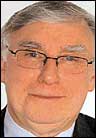CASAGRAS (Coordination and Support Action for Global RFID-related Activities and Standardization), an 18-month E.U.-funded project being carried out by an international group of companies and organizations working on RFID and other standards, has received initial positive feedback from the European Union regarding its interim report, according to Ian Smith, one of the project’s coordinators, who declines to provide any details regarding the E.U.’s response.
The report says the so-called Internet of Things should not be developed exclusively around radio frequency identification, but should make use of other automatic identification and data capture technologies as well, while also incorporating new sensor and communication technologies and networks. This includes “ubiquitous computing,” which the report defines as a system “in which computing devices are considered integrated into everyday objects to allow them to communicate and interact autonomously and provide numerous services to their users.” In addition, the report adds, it should work together fully with the Internet.
The Internet of Things is often seen as a network of physical objects and infrastructure that interact with each other, often autonomously. It is viewed as the connection of the virtual world—the Internet—to the physical world, through electronically identified physical objects. The concept is defined in widely differing ways, however—and that’s part of the problem being tackled by CASAGRAS’ partners, which include representatives from YRP Ubiquitous Networking Laboratory, in Japan; the Hong Kong Science and Technology Parks Corp. (HKSTP); the Electronics and Telecommunication Research Institute (ETRI), in Korea; FEIG Electronic, in Germany; the European Telecommunications Standards Institute (ETSI); and Q.E.D. Systems, in the United States. Their first priority was to consider the role of RFID in the emerging concept of the Internet of Things. However, this became nearly impossible because the partners determined that the concept of the Internet of Things is far from defined on a broad international basis.
According to Smith, who also is the CEO of AIDC UK, and Anthony Furness, the AIDC’s technical director, the Internet of Things is a world in which things can communicate with people and to computers, and systems can “talk” to each other. It exploits the Internet, networking, mobile and fixed communications, and associated technologies to provide interconnected services and applications.
One example is a smart household refrigerator that can interact with its contents, recording when something is put away or taken out, while also keeping track of the expiry dates and freshness of everything within it. Another example is a transport network system along a motorway that can gather and relay information regarding road conditions to a car in relation to a driver’s specific journey needs. At the same time, it advises maintenance teams about the condition of the road surface and the motorway. Meanwhile, Furness says, the car can read smart cards in the pockets of the driver and passengers, automatically setting temperature and seating position according to their preferences, and even playing predesignated music on the audio system.
In the retail sector, the Internet of Things application could be used to allow goods in a department store to communicate with the store computer, alerting the store when they are moved to the wrong location, or when they are taken without payment. It could be a supermarket shelf “talking” to a customer’s mobile phone, alerting that person to allergy risks, country of origin, ingredients or carbon miles.Launched in January 2008, CASAGRAS was set up to provide studies to help the European Commission and the global community shape RFID policy. It was also designed to initiate collaboration among the European Union, Korea, Japan, China and the United States for defining standards regarding the Internet of Things.
The CASAGRAS project submitted its findings after seven months of work led by Smith and Furness. The AIDC is funded by a U.K. state economic development agency, and is charged with helping companies in that area adopt automatic ID technologies (see U.K. Auto-ID Center Focuses on Small, Midsize Firms). In addition to this work, the organization is heading up the CASAGRAS project, now a leading effort to define what the Internet of Things actually means in terms of scope and scale.
“There has been a lot of rhetoric on the Internet of Things,” Furness says, “but up to now, there has been no clear definition on the framework of it, and how it will integrate with the Internet itself.” Some people, he adds, are already working on component parts for such a structure, and on applications for the Internet of Things, even though its framework has not yet been clearly defined.
Furness and others working on the CASAGRAS project have not yet come up with a final recommendation for a definition based on broad international support, but their interim report moves the project closer to meeting that goal. To date, Furness and Smith indicate, it has three main findings.
First, the report says, the Internet of Things must be inclusive of a variety of technologies: It must allow for many ways to identify physical objects and their locations in order to accommodate existing and emerging technologies. Besides RFID, such technologies include linear bar codes, Matrix 2-D bar codes and natural-feature technologies such as speech recognition, biometrics and developments in feature recognition that are applied to physical and biological objects.
Second, the Internet of Things must take into account legacy identification systems. This refers to the so-called “global coding problem” resulting from a wide variety of object-identification systems including the GS1 numbering system, the EPC system and ubiquitous ID, a numbering system employed in Japan and in other parts of Asia.CASAGRAS’ partners from around the world say a single global system capable of replacing legacy systems is unlikely to be created. “Difficulties in achieving agreement and migration from other systems would preclude such a development,” Furness says.
Therefore, the partners say their mission is to discover a solution that resolves the problem of different coding systems through the use of a so-called “resolver scheme” that would accommodate legacy systems. Such a scheme would probably be based upon the use of the Universal Resource Identifier (URI), a string of characters used to identify or name a resource on the Internet, such as a Uniform Resource Names (URN) or an Object Identifier (OID).
Finally, Furness and Smith say the Internet of Things should be designed to provide software and hardware “bus” structures, for transferring data from one entity to another. These should be in the form of service-oriented architecture (SOA) and universal data appliance protocols that can be a basis for developing federated networks and services, they add. This would allow people to design “plug-and-play” applications. According to Furness, a simple application would be a sensor-based security support service for buildings in which networks of ID-based sensors monitor conditions and transmit information wirelessly to a service support point. There, it is analyzed and utilized for the basis of automatic controls or other computer-based decisions or alerts.
“This is only scratching at the surface of the service support potential for the Internet of Things,” Furness says. “There are other large-scale examples that involve millions of objects connecting within networks and communicating with other objects to satisfy object-based services and applications.”
At a later date, CASAGRAS plans to report on possible applications for the Internet of Things. Furness declines to do so at this point, however, saying he does not want to preempt the outcomes of the respective CASAGRAS work packages and the final report.
CASAGRAS will host a free seminar in Shanghai on Dec. 1, intended to solicit opinion in the region on how the Internet of Things should be defined and built. Speakers will cover the European 4-Channel Plan (a plan that allows the operation of an unlimited number of RFID readers in each of the four transmit channels in Europe), a framework model for the Internet of Things, the role of RFID within the Internet of Things, networking and interfacing with the physical world, the need for global coding and resolution schemes, services based on the Internet of things, privacy, security and governance.
The meeting will be followed on Dec. 4 by a joint GRIFS/CASAGRAS workshop to be held in Hong Kong. Click here to register and find out more. GRIFS is a project working to design a platform for worldwide collaboration on RFID standards.



